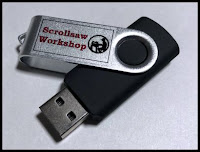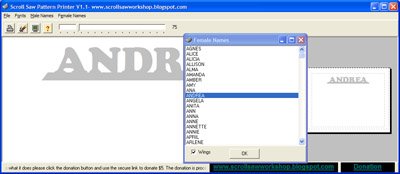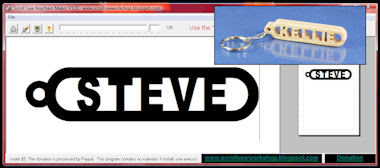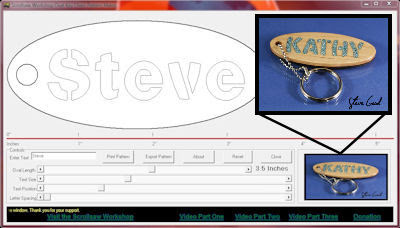Download the Pattern Below
This would be a fun puzzle for the Sunday school classroom at church. It is a stand-up puzzle cut from 3/4" thick wood.
When you are cutting thick wooden puzzles you need to consider how tightly the pieces fit together. The smaller the blade the tighter the pieces will fit. For stand-up puzzles, you want a snug fit. The problem with a snug fit is it requires a small blade which can be difficult to get a 90 degree cut top to bottom of the thick board.
For smaller children, the pieces can be a little looser. That makes the puzzle easier to assemble. The pieces may droop a bit if they are too loose but that is better than not fitting together.
I wanted a very tight fit. I used a #2/0 blade. To use a blade that small I had to be very careful to get a square cut. I needed to cut slowly and be careful not to flex the blade in the cut.
I tried to design the puzzle so even if the fit is loose the puzzle will still stand up. I did not test it but I believe you could even use a #5 blade and get the puzzle to stand.
Do you hate sanding fuzzies? Tip from Jeff Briggs.
I received an email from Jeff Briggs today. He was experimenting with pre-finishing projects and came up with this nice extra benefit. Reduced fuzzies on the backside of his cuts and very clean veining.
I have not had an opportunity to give this technique a complete test but my initial quick tests show the same results as Jeff explains below.
Here is the text from Jeffs's email.
I have been experimenting with pre-finishing some pieces before I cut them. The idea came to me when I was explaining to someone about adding a finish to wood will actually strengthen the surface and make it harder (non-scroll saw project). My go-to finish is one coat of spray shellac that gets struck off with 000 steel wool and then as many coats of spray lacquer as the piece needs.
I decided to do the shellac on both sides before I applied and cut the pattern. While this adds a bit to the preparation time the results were spectacular to say the least. Take a look at the images in the attached Photos.
I don’t think this process is something that is necessary for every project but if someone needs that extra dose of crispness on a particular project then this may be a solution. I have not shown the finished project but I did still give the piece a light sanding and multiple coats of lacquer but I did not spend much time at all on getting rid of the fuzzies.
All photos can be clicked to enlarge.
Clear shelf liner with spray mounted pattern.
Mat be tough to see but the drilled holes are
only raised about 50% of the normal height.
The back has no lifting of the surface.
Jeff is using plywood here. It is common for there to be tear-out and chips lifting from
blowout on the back. Using a backer board as you drill helps also.
The front has standard clean cuts,
no surprises here.
The back is very clean. This has not
been sanded or cleaned up.
That is pretty impressive for the back of the plywood.
Closeup of the back where long cuts were
made along the grain. This is always where
you get the most fuzzies, and there are still
some but significantly fewer. Oh, and look at
the crisp veining.
Getting clean veining is tough. It normally takes a good deal of time to remove the fuzzies and dust from the veins. I will often use an Exacto blade to dig them out. Preventing them in the first place is awesome.
$12 per sheet of 12 coins plus $3.50 shipping
Inlay with a 1" Forstner Bit.
The perfect way to sign your work.
- -
Email Newsletter Readers: Remember that the Newsletter is just a copy of the daily blog post. To see the post in its proper formatting click this link. If you ever misplace a pattern or any item you see here you can always find it on the blog. Everything stays on the blog forever.
Products for your consideration:
Every Scrollsaw Workshop Pattern from 2007-2020 on DVD
Purchase the entire Scrollsaw Workshop pattern catalog for offline access.
This DVD has over 3,310 patterns published from 2007 thru 2020.
The DVD is $20 plus shipping. Ships to 60 countries around the world.
If you use the DVD on a Windows PC there is a simple viewer program to browse through the patterns.
The DVD also works fine on a MAC. The viewer program is not MAC compatible but there is an included PDF with all the patterns shown as thumbnails for easy viewing.
Now Available on USB Thumb Drive
Don't have a DVD drive on your new computer. No problem. Buy the catalog on a USB thumb drive.
All the same file but in an easy to use thumb drive. The USB thumb drive option is $23 plus shipping.
Unique Wooden Vases:
Want to create beautiful wooden vases on the scroll saw?
The Scrollsaw Workshop is primarily supported by donations. If you enjoy this Blog and would like to make a donation please click this Button. Your support is greatly appreciated.

My Sponsors:
Support the businesses that support our community.
Home of Pegas scroll saw blades.
The standard blade clamps on the Delta and DeWalt scroll saws will eventually wear out and need to be replaced. The Pegas replacement blade clamps are a superior clamp and make a reliable replacement. Many scrollers have replaced the clamps even before their stock clamps fail.
These Blade Chuck Heads” (also known as Blade Clamps) were developed in Switzerland by Pégas in association with the HEIG engineering school in Yverdon.
The studies and the tests demonstrated that the weight of these heads is in direct relation with the service life and the vibrations of the machine.
See Steve Good of the Scroll Saw Workshop's full review, plus detailed assembly instructions.
This Set includes lower and upper blade clamps compatible with the Dewalt DW788-20 inch scroll saw, and the Delta 40-694-20 inch scroll saw. Works perfectly for BOTTOM and TOP feeding scrollers.












































